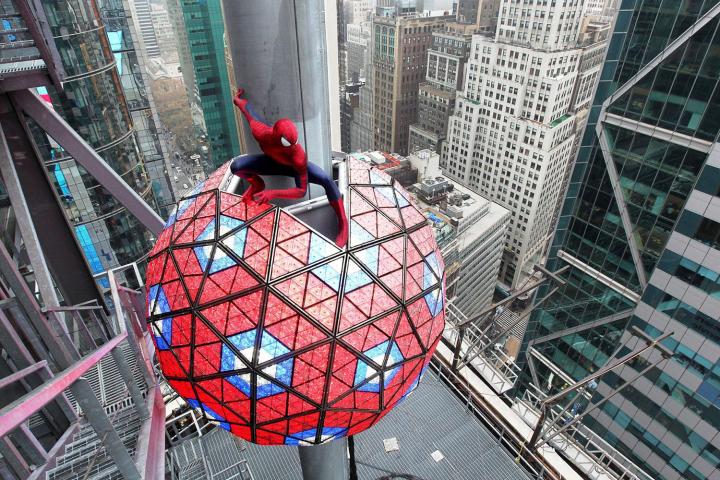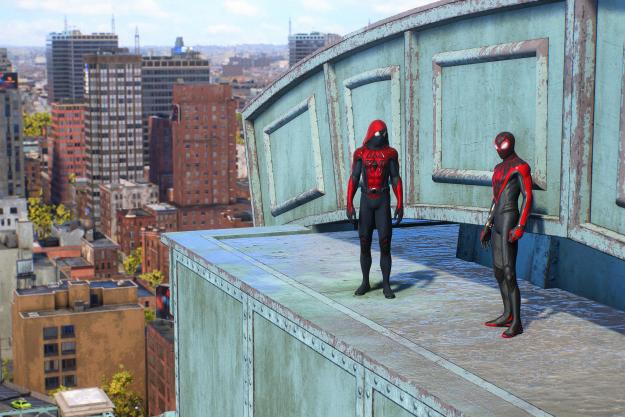
It’s incredibly hard to film an action film without digital-heavy visual effects these days, much less a superhero flick. The only franchise to use such techniques sparingly in recent memory is The Dark Knight Trilogy; Christopher Nolan only turned to digital artists when absolutely necessary.
Like its predecessor, The Amazing Spider-Man 2 leans heavily on digital effects, but the FX team at Sony Imageworks is committed to keeping the action as real as possible. Visual Effects Supervisor Jerome Chen, Animation Supervisor David Schaub, and Digital Effects Supervisor David Smith all brought up “real physics” more than once during our sitdown at Sony Imageworks. But this isn’t about flipping an 18-wheeler over, something that – after copious amounts of planning – could actually be achieved without the use of computers. Real physics, as Schaub put it during his presentation, is all about “seamlessly merging the fantastical with the physical.”
Spider-Man blends the fantastic with the physical better than any other superhero.
The Imageworks animation team had a set of guidelines in place for The Amazing Spider-Man 2, and these guidelines were set in stone to give the animated Spider-Man the same look and feel as Andrew Garfield in a suit. Gravity, Newton’s Laws, accurate scale to speed, accurate weight representation, and aerodynamics were all paramount when animating action sequences. The same can be said of many movies, but rarely do protagonists move and fight like Peter Parker.

Perhaps the greatest meeting of fantastical and physical in The Amazing Spider-Man 2 is Spidey’s fight with Electro in Times Square. This sequence took over a week to shoot, with time split between Times Square and a Long Island soundstage. And between the shooting, pre-production, and post-production work, the scenes took about one year to complete.
Two days of shooting in Times Square was complemented by a week of set time at the Long Island location. The initial two days give the sequence a very real New York City aesthetic, but tossing cars and fighting with lightning is definitely animation and VFX territory. In order to create a world in which the animation team could go to work, Smith oversaw a photographic mapping of Times Square.
Location scouts snapped 36,000 photos (under the careful eye of the NYPD counter-terrorism squad) of the square, all of which were stitched together over geometry built by the animation team. During the shooting days on Long Island, dozens of shipping containers were covered in green screen to re-create some of the necessary Times Square structures, which the stitched photography was laid over in post.
Capturing Times Square in such a way has never been done before, and the method should be a boon to Hollywood for years to come. All the visuals, lighting data, and building data captured for the Times Square sequence could be used in virtually any film with a Times Square shot. Sony now has a treasure trove of data on one of America’s most sought-after shooting locations.
Advertising is another factor, as the animation team captured over 100 billboards during the photography process. While some of the more famous signs and ads remain unchanged, the billboards that change every few weeks or months will go one of two ways. The ads could be up to date (within a few weeks of release, anyway) with whatever is hanging in the square, or the ads could be replaced with content provided by Sony’s marketing department. “Forget about what’s there,” Smith said of his conversations with Sony marketing, “and just tell us what you want there.”
With the kind of effort and fantastical-physical blending seen in The Amazing Spider-Man 2, calling the film out for lackluster visuals will be a challenge come review time. While the jury is still out on shots with the film’s other villains, Spider-Man’s tangos with Electro are an admirable effort to combine the fantasy of Marvel with the realism of New York City.
Editors' Recommendations
- This PS5 bundle saves you $70 on the console and Spider-Man 2
- The best video games of October 2023: Mario, Spider-Man 2, and more
- Marvel’s Spider-Man 2 lets its villains evolve in ways comics never could
- How to run the bases at Big Apple Ballers Stadium in Spider-Man 2
- How to change suits in Spider-Man 2






